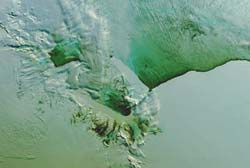More than 150 researchers from across Europe, Canada, the United States, China and as far away as Chile have come together to recount their many and varied uses of a single instrument – a desk-sized camera called MERIS, hurtling through space aboard Envisat at more than seven kilometres per second.
The Medium Resolution Imaging Spectrometer (MERIS) is one of ten sensors on Envisat, looking down from the earthward face of the spacecraft. It works by recording visible and near-infrared radiati

The tropical mantis shrimp has the most sophisticated eyes of any creature on the planet, yet it often lives at murky depths where the only light is a filtered, dim blue. Why does it need such complex vision?
Marine biologists and physiologists have now discovered at least one use for these eyes in the deep, blue ocean: to see the fluorescent markings mantis shrimp use to signal or threaten one another.
The shrimps’ characteristic spots are easy to see in shallow water but o
Large, deep earthquakes have shaken the central Puget Sound region several times in the last century, and nerves have been rattled even more often by less-powerful deep quakes. New University of Washington research suggests the magnitude of these temblors might depend on just where beneath the Earth’s surface they occur.
Events such as the 2001 Nisqually earthquake and large quakes in 1965 and 1949 happened in what is called the Wadati-Benioff zone, an area deep below the surface where

ESA’s Envisat satellite was witness to the dramatic last days of what was once the world’s largest iceberg, as a violent Antarctic storm cracked a 160-km-long floe in two.
A series of Envisat Advanced Synthetic Aperture Radar (ASAR) instrument images acquired between mid-September and October record how the bottle-shaped iceberg B-15A was split by the onslaught of powerful storms, waves and ocean currents as its own weight kept it fixed on the floor of Antarctica’s Ros
As mountains of scrap tires continue to rise above the landscape, researchers at the University of Wisconsin-Madison have found an environmentally friendly use for them: grind them up and place the rubber bits beneath golf course greens.
In a paper accepted for publication in the journal Waste Management, the researchers show that these ground tires can absorb excess chemicals from fertilizers and pesticides, preventing them from leaching into groundwater and contaminating the surrounding enviro
Almost all of the active volcanoes on Earth lie beneath miles of seawater at mid-ocean ridges, creating the long chain of volcanic mountains that encircles the Earth like the seam of a baseball. Scientists have long been puzzled by the observation that flows, erupted as white-hot lava at mid-ocean ridges, can be traced for several miles from their vents despite the fact that they erupt into seawater close to its freezing point. Now a group of scientists from academia and government believe they have